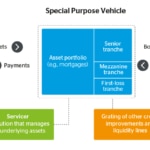Getting a bank’s balance in shape
Banks play a critical role as providers of funds to the real economy. In this regard, the active management of the balance sheet has become more and more important, and is now a strategic area for financial institutions. Some of its key goals are guaranteeing liquidity, strengthening solvency and reducing exposure to credit risk.

Financial institutions have different mechanisms to manage their balance. One of the most used tools is securitization. But it is not the only one. Formulas such as loan refinancing or restructuring to help borrowers meet their payment obligations, through the sale of loan portfolios, are also used on a regular basis.
Traditional securitization: what is it and what is it used for.
Through this process, an institution is capable of turning a series of heterogeneous low-liquidity financial assets into liquid homogeneous instruments (normally obligations or bonds), that can be traded in the market.
This mechanism entails transferring an asset portfolio (loans, for example) from the balance of the institution to a vehicle without assets or equity, which will issue bonds backed by said portfolio. Normally, several bond tranches are issued in each securitization, each with a different risk-level to appeal to different investor types. Most of the times, the part of the bond issue with higher risk and lower credit rating (known as equity or first-loss tranche) remains in the balance of the issuing bank, in order to improve the credit rating of the remaining tranches and thus making them easier to sell to investors.
Asset securitization allows institutions to attract liquidity (by placing asset-backed securities in the market) and transfer asset-related risk to the vehicle issuing the bonds. This allows lowering regulatory capital needs by reducing the total amount of risk-laden assets in the balance.

The shutdown of the securitization market – Another consequence of the financial crisis
Before the crisis, financial institutions were capable of selling all tranches of a securitization, and therefore to generate liquidity and free up provisions and capital.
In the U.S. the securitization of the so-called subprime mortgages became had become a common practice. A subprime mortgage is a mortgage taken out by borrowers with scarce economic resources and high chances of default. These mortgages were packaged and sold by tranches, some of them considered low-risk (with high-ratings). The burst of the U.S. real-estate bubble in 2007 resulted in widespread defaults on this type of mortgages, whose risk had been transferred to the securitizations. Investors that had purchased the corresponding securitization bonds were directly affected.
That is when securities started being demonize, as they were deemed to have triggered of the recent financial crisis. As pointed out by Iñaki Echevarría, Head of Securitization and Capital Base Management at BBVA “although it is true that in the U.S. securitizations played a key role triggering the crisis, in the case of Europe, were no subprime mortgages were commercialized, it wasn’t so. European securitizations had high credit quality and plummeted as the result of an unfair contagion effect that resulted in the shutdown of the market for this type of products.” The European Banking Authority (EBA) has also expressed itself in similar terms.
Since then, the role of securities from a balance sheet management standpoint has changed. There are not sufficient incentives for them to be issued in the market, as the regulator penalizes those who invest in securities, establishing higher capital consumption requirements compared to similar products, such as the Spanish cédulas hipotecarias, a type of covered bond. Thus, one of the incentives that drove financial institutions to issue securitizations (transferring the risk from the balance sheet) has been lost.
Currently, the main motivation that banks have to securitize is to increase liquidity. Securitizations allow banks to bring loans to the European Central Bank (ECB) loans that would not be admitted as collateral to obtain liquidity at a discount rate. In any case, the eligibility criteria established by the ECB to allow a securitized asset to be pledged as collateral are very strict. Only mortgage securitizations, consumer loans or SME loans are accepted by the European monetary authority. On top of this, some limitations are applied which are linked to the securitization’s rating, which is linked to the issuer’s rating and therefore to the rating of the country where the bond is issued. To this regards, bond issues by institutions from periphery countries are less efficient at the time of being accepted as collateral by the ECB.
Why is it necessary to reactivate the securitization market
Securitizations have been one of the most effective formulas to pump credit into the real economy. We are at a time when plenty of financial institutions are undergoing deleveraging processes and are also following a somewhat risk-averse approaches. All this is having an impact on the generation of credit flows, which is struggling to gain momentum. The reactivation of the securities market could be one of the solutions. Different initiatives have been set forth for this purpose, not by issuers and investors, but also by regulators and supervisors. The most noteworthy are:
- Homogenization of regulatory requirements for securitizations with similar instruments, such as covered bonds.
- Pledging of collaterals or direct purchase of securitization tranches or synthetic issuances by supranational institutions. This would allow breaking the bond between securitization and sovereign ratings For example, the European Investment Fund (EIF), whose majority shareholder is the European Investment Bank (EIB) purchases securitization tranches directly, extends guarantees over loan portfolios and buys synthetic securitizations. Another program is the FTPYME, an SME loan securitization scheme, whereby the Spanish Treasury provides guarantees on securitization tranches. In some cases, certain securitizations guaranteed by public or quasi-public institutions require beneficiaries to reinvest part of the invested funds in new loans. This mechanism has proven to be a very effective way to generate a flow of credit in the real economy.
- Risk distribution: These supranational institutions could commit to purchase a part of the first-loss tranche, thereby limiting the risk assumed by financial institutions, thus increasing their margin for granting loans.
Synthetic securitizations: a solution that is garnering increasing support
In recent years, synthetic securitization has become one of the most widely accepted methods for freeing up capital and provisions. In this type of operations, the loan portfolio is not transferred to an investment vehicle; instead, the loan remains in the corresponding institution’s balance sheet, but the institution transfers the risk of default (calculated applying Basel’s oversight formula) to a third party. The most common way of transferring this right is through the signing of a derivative that is realized on the portfolio, known as Credit Default Swap, or CDS.
As indicated by Diego Martín Peña, of BBVA's securitization team, “the purpose of this type of institution is to transfer balance sheet risk and freeing up capital, in a way such that it facilitates the granting of new loans to families, small and medium sized enterprises, while reducing the costs typical of a traditional securitization, which are typically legal and administrative.”
Refinancing: a measure used during the crisis to help customers meet their payments.
Another tool to put a bank’s balance sheet back in shape is debt refinancing. In Spain, the economic crisis forced financial institutions to make an effort to adapt to the payment capacity of their customers. Refinancing schemes emerged as a tool to mitigate the difficult situation of customers that were having problems to meet their loan payments, offering them more favorable financing conditions, by adjusting either their rates or deadlines.
For example, in the case of BBVA, as of the end of 2015, the bank had 67,050 refinancings in effect. These were granted to customers with difficulties in making their mortgage loan payments, as reflected in the BBVA in 2015 report.
Sale of portfolios
Finally, we will take a look at the sales of loan portfolios, normally consisting of NPLs, or Non-Performing Loans. This is a tool that removes non-performing assets from a bank’s balance sheet. It also allows banks to focus their activity on their core business – lending – and relieve their commercial network from the burdening task of managing loan defaults. Buyers are usually investment firms specializing in managing these impaired assets.
According to Antonio San Frutos, Professor at CUNEF School of Finance and Management "if through the sale of impaired physical assets or through the sale of non-performing loan investment portfolios assets risk is reduced and thus the regulatory capital is increased, improving solvency ratios, there is a chance on the assets side of the balance sheet to carry out new and more profitable operations.”
In Nordic and Anglo-Saxon countries, bad debt selling has been a common practice for years. In the case of Spain, the sale of NPL portfolios surged after the burst of the real-estate bubble and the impairment of assets to the real-estate and developer markets. Since then, most financial institutions have a non-performing asset management unit, responsible for selling a part of NPLs to the market. Based on each portfolio’s segment – promoter loan, SME loan, mortgage-backed assets – potential buyers are invited to take part in a competitive auction process by the institutions.
The ECB, aware of the relevance of credit flows for the economy, just published a guide to encourage banks to manage their non-performing loans. The document is not binding, but contains the policies and good practices in different countries regarding how to reduce their NPL portfolios. Thus, it could result in direct requirements for banks that fail to implement them.
Ultimately, the ECB’s intent is to prevent banks from accumulating NPL loans in order to ensure that they can focus on granting loans. To prevent this from happening, the ECB recommends deploying a full-blown range of strategic and corporate governance tools related to the management of the non-performing asset. From deciding the NPL level that each bank is ready to manage, to the availability of fast-evacuation tools, such as the sale of portfolios, that help preserve the health of the financial system.